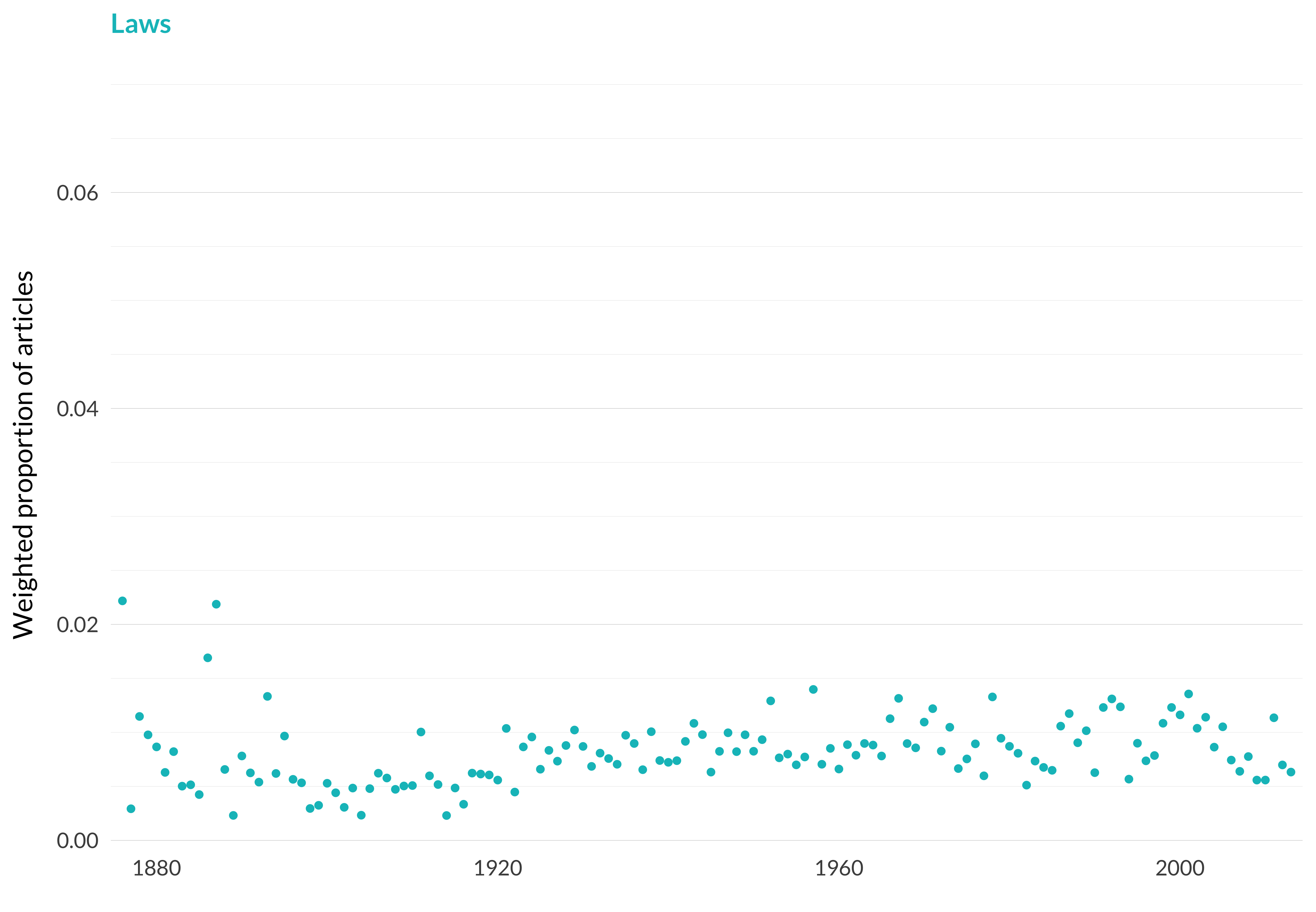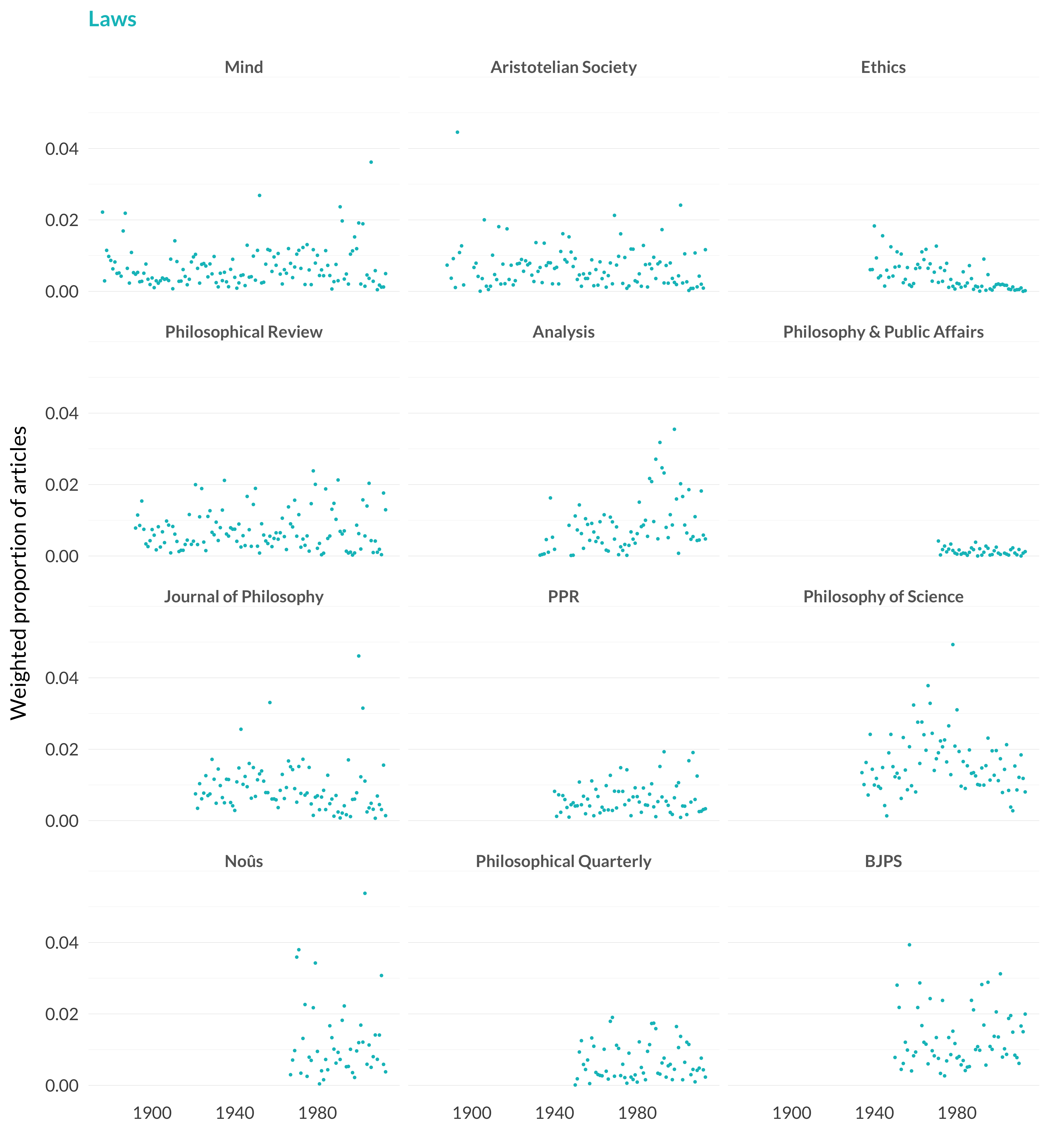2.46 Laws
Category: Philosophy of Science
Keywords: regularity, laws, paribus, ceteris, nomic, regularities, generalizations, miracle, generalization, law, accidental, event, match, deterministic, counterfactuals
Number of Articles: 201
Percentage of Total: 0.6%
Rank: 73rd
Weighted Number of Articles: 282.2
Percentage of Total: 0.9%
Rank: 54th
Mean Publication Year: 1977.8
Weighted Mean Publication Year: 1970.9
Median Publication Year: 1981
Modal Publication Year: 1971
Topic with Most Overlap: Ordinary Language (0.0429)
Topic this Overlaps Most With: Explanation (0.046)
Topic with Least Overlap: Beauty (0.00027)
Topic this Overlaps Least With: Population Ethics (0.00094)

Figure 2.111: Laws.

Figure 2.112: Laws articles in each journal.
Comments
This looks like a small topic, but that’s largely because it gets squeezed between so many other topics. It ends up as a natural philosophy of science topic, though most of the topics around it are in metaphysics. The weighted number of articles is so much higher than the raw number because so many papers in other topics are also in large part about laws.
For instance, papers about explanation in a broadly Hempelian tradition are often classified as being about explanation, even if they are in no small part about laws as well. See, for example, this paper which is very squarely in the Hempelian tradition.
| Subject | Probability |
|---|---|
| Explanation | 0.2479 |
| Laws | 0.1926 |
| Verification | 0.1061 |
| Methodology of science | 0.1037 |
| History and culture | 0.0857 |
| Definitions | 0.0670 |
| Theory testing | 0.0608 |
| Marx | 0.0484 |
| Analytic/synthetic | 0.0268 |
And some papers about the necessity of laws get classified as either papers about modality or, less commonly, chemistry.
| Subject | Probability |
|---|---|
| Chemistry | 0.2821 |
| Laws | 0.2320 |
| Modality | 0.1396 |
| Mechanisms | 0.0598 |
| Ontological argument | 0.0419 |
| Arguments | 0.0416 |
| Ordinary language | 0.0405 |
| Knowledge | 0.0308 |
| Composition and constitution | 0.0291 |
Some papers that are largely about laws are also largely about chances and get put there.
| Subject | Probability |
|---|---|
| Chance | 0.3606 |
| Laws | 0.2047 |
| Composition and constitution | 0.1351 |
| Formal epistemology | 0.0412 |
| Arguments | 0.0378 |
| Kant | 0.0350 |
| History and culture | 0.0296 |
| Quantum physics | 0.0266 |
| Modality | 0.0247 |
| Temporal paradoxes | 0.0213 |
Many papers that are about laws are also about causation and other topics.
| Subject | Probability |
|---|---|
| Causation | 0.1435 |
| Ordinary language | 0.1007 |
| Laws | 0.0946 |
| Meaning and use | 0.0792 |
| Methodology of science | 0.0740 |
| Composition and constitution | 0.0615 |
| Theories and realism | 0.0467 |
| Modality | 0.0420 |
| Models | 0.0381 |
| Physicalism | 0.0362 |
| Concepts | 0.0333 |
| Space and time | 0.0311 |
| Personal identity | 0.0251 |
| Idealism | 0.0205 |
And, of course, there are plenty of papers about laws in the topics on the special science.
| Subject | Probability |
|---|---|
| Evolutionary biology | 0.2419 |
| Laws | 0.1755 |
| Theory testing | 0.1372 |
| Methodology of science | 0.1111 |
| Ordinary language | 0.0814 |
| Models | 0.0467 |
| Explanation | 0.0428 |
| Analytic/synthetic | 0.0376 |
| Sets and grue | 0.0341 |
The same does happen in the other direction. Some papers that are about several of these topics do get classified (barely) in the laws of nature topic.
| Subject | Probability |
|---|---|
| Laws | 0.2379 |
| Modality | 0.2346 |
| Ordinary language | 0.2085 |
| Time | 0.1563 |
| Causation | 0.0387 |
| Vagueness | 0.0225 |
But mostly it’s the other way around. And that makes sense. As interesting as laws of nature are as a topic in their own right, a huge part of their philosophical interest comes from the role they play in clarifying other things we care about. And that’s what the model reflects.